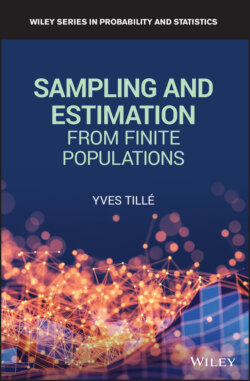Читать книгу Sampling and Estimation from Finite Populations - Yves Tille - Страница 21
1.10 Recent References and Development
ОглавлениеThe books of precursors are Yates (1946, 1949, 1960, 1979), Deming (1948, 1950, 1960), Thionet (1953), Sukhatme (1954), Hansen et al. (1953a,b), Cochran (1953, 1963, 1977), Dalenius (1957), Kish (1965, 1989, 1995), Murthy (1967), Raj (1968), Johnson & Smith (1969), Sukhatme & Sukhatme (1970), Konijn (1973), Lanke (1975), Cassel et al. (1977, 1993), Jessen (1978), Hájek (1981), and Kalton (1983). These books are worth consulting because many modern ideas, especially on calibration and balancing, are discussed in them.
Important reference works include Skinner et al. (1989), Särndal et al. (1992), Lohr (1999, 2009b), Thompson (1997), Brewer (2002), Ardilly & Tillé (2006), and Fuller (2011). The series Handbook of Statistics, which is devoted to sampling, was published at 15‐year intervals. First, a volume headed by Krishnaiah & Rao (1994), then two volumes headed by Pfeffermann & Rao (2009a,b). There is also a recent collective work led by Wolf et al. (2016).
The works of Thompson (1992, 1997, 2012) and Thompson & Seber (1996) are devoted to sampling in space. Methods for environmental sampling are developed in Gregoire & Valentine (2007) and for forestry in Mandallaz (2008). Several books are dedicated to unequal probability sampling and sampling algorithms. One can cite Brewer & Hanif (1983), Gabler (1990), and Tillé (2006). The model‐based approach is clearly described in Valliant et al. (2000), Chambers & Clark (2012), and Valliant et al. (2013).
Many relevant books have been published and are still available in French. One can cite Thionet (1953), Desabie (1966), Deroo & Dussaix (1980), Gouriéroux (1981), Grosbras (1987), Dussaix & Grosbras (1992), Dussaix & Grosbras (1996), Ardilly (1994, 2006), Ardilly & Tillé (2003), and Ardilly & Lavallée (2017). In Italian, one can consult the works of Cicchitelli et al. (1992, 1997), Frosini et al. (2011), and Conti & Marella (2012). In Spanish, there exist also the books of Pérez López (2000), Tillé (2010), and Gutiérrez (2009) as well as a translation of the book of Sharon Lohr (2000). In German, one finds the books of Stenger (1985) and of Kauermann & Küchenhoff (2010). Finally, in Chinese there is a book by Ren & Ma (1996) and in Korean by Kim (2017).
Recently, new research fields have been opened. Small area estimation from survey data has became a major research topic (Rao, 2003; Rao & Molina, 2015). Recent developments in survey methodology are described in Groves (2004b) and Groves et al. (2009). Indirect sampling involves the selection of samples from a population that is not the population of interest but has links to it (Lavallée, 2002, 2007), for example new sampling algorithms have been developed to select balanced samples (Tillé, 2006). Adaptive sampling consists of completing the initial sample based on preliminary results (Thompson, 1992; Thompson & Seber, 1996). Capture–recapture methods are used to estimate the size of animal populations. Variations of these methods sometimes allow rare population sizes to be estimated or coverage surveys to be carried out (Pollock, 2000; Seber, 2002).
Resampling methods have been developed for finite populations (Shao & Tu, 1995; Groves, 2004b). Of course measurement errors will always remain a major research topic (Fuller, 1987; Groves, 2004a). Finally, substantial progress has been made in nonresponse methods: reweighting methods or imputation techniques (Särndal & Lundström, 2005; Bethlehem et al., 2011; De Waal et al., 2011; Kim & Shao, 2013).
One of the challenges that is currently emerging is the integration of data from multiple sources: administrative files, registers, and samples. In a thoughtful article entitled Big data: are we making a big mistake?, Tim Harford (2014) reminds us that the abundance of data is never a guarantee of quality. Access to new sources of data should not make us fall back into the mistakes of the past, as was the case during the 1936 US presidential election (see Section 1.5, page 6).
There have been methods for decades to integrate data from different sources. However, the multiplication of available sources makes these integration issues more and more complex. There is still a lot of research and development work needed to define the methods for integrating data from multiple sources by appropriately addressing the different measurement errors.
